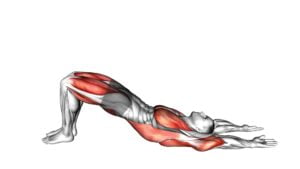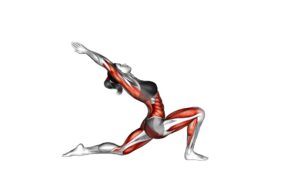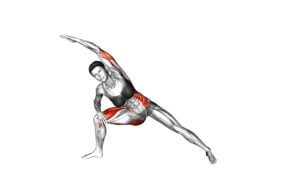Bridge Pose Setu Bandhasana (female) – Video Exercise Guide & Tips

Get ready to strengthen and stretch your body with Bridge Pose Setu Bandhasana. In this video exercise guide, we'll show you how to properly perform this pose, along with helpful tips to improve your practice.
Watch This Exercise Video
Whether you're a beginner or an experienced yogi, this guide has modifications and variations for all levels. So grab your mat, hit play, and start reaping the benefits of this empowering pose.
Let's get started!
Key Takeaways
- Bridge Pose Setu Bandhasana strengthens the back, glutes, and hamstrings.
- It opens the chest and stretches the shoulders.
- The pose helps alleviate back pain, improve posture, and reduce stress, anxiety, and mild depression.
- Bridge Pose Setu Bandhasana stimulates the parasympathetic nervous system, promotes calm and relaxation, and enhances mental well-being.
Benefits of Bridge Pose Setu Bandhasana
Experience the benefits of practicing Bridge Pose Setu Bandhasana to strengthen your back and open your chest. This yoga pose offers modification options to accommodate various fitness levels and body types, making it accessible to everyone. By lying on your back and lifting your hips off the ground, you engage your glutes, hamstrings, and lower back muscles, effectively strengthening them over time. This can help alleviate back pain and improve posture.
In addition to its physical benefits, Bridge Pose Setu Bandhasana also has positive effects on your mental health. As you hold the pose, you may notice a sense of calm and relaxation wash over you. This is because Bridge Pose stimulates the parasympathetic nervous system, which is responsible for the body's 'rest and digest' response. By activating this system, the pose can help reduce stress, anxiety, and even mild depression.
Furthermore, Bridge Pose Setu Bandhasana opens up the chest and stretches the shoulders, counteracting the effects of prolonged sitting and hunching over electronic devices. This can improve breathing and lung capacity, boosting overall well-being. Incorporating this pose into your regular yoga practice can provide both physical and mental benefits, making it a valuable addition to your routine.
Preparing for the Pose
To prepare for the Bridge Pose Setu Bandhasana, start by lying on your back and engaging your core muscles. This pose requires a good warm-up to ensure your body is ready for the challenge. Here are some preparation techniques and warm-up exercises you can incorporate into your routine.
First, start with some gentle stretches for your back and hips. You can try knee-to-chest stretches or gentle twists to loosen up these areas. This will help to increase flexibility and prevent any strain during the pose.
Next, focus on strengthening your glutes and hamstrings. Bridge Pose Setu Bandhasana requires a strong lower body, so incorporating exercises like squats, lunges, and leg lifts into your warm-up routine can help build the necessary strength.
Additionally, it's important to engage your core muscles during the warm-up. Plank exercises or abdominal crunches can be effective in activating and strengthening your core.
Remember to listen to your body and go at your own pace. If you feel any discomfort or pain during the warm-up, modify or skip certain exercises. It's important to gradually build up your strength and flexibility to avoid injuries.
Step-by-Step Guide to Bridge Pose Setu Bandhasana
Lie on your back, bend your knees, and place your feet hip-width apart to begin Bridge Pose Setu Bandhasana.
Follow these steps to properly practice this pose:
- Press your feet firmly into the mat, keeping your arms alongside your body.
- Inhale deeply, lifting your hips off the mat while pressing down through your feet and shoulders.
- Keep your thighs parallel to each other and engage your glutes and core muscles.
- Lengthen your tailbone towards your knees and keep your neck relaxed.
- Hold the pose for a few breaths, then exhale as you slowly lower your hips back down to the mat.
Bridge pose modifications can be made to accommodate different levels of flexibility and strength. You can place a block under your sacrum for added support or interlace your fingers underneath your body to deepen the stretch.
Benefits of backbends, like Bridge Pose Setu Bandhasana, include:
- Strengthening the back, glutes, and hamstrings.
- Opening the chest and shoulders, improving posture.
- Stimulating the thyroid and pituitary glands.
- Relieving stress and anxiety.
- Increasing energy and promoting a sense of calm.
Remember to listen to your body and only go as far into the pose as feels comfortable. With practice, you can gradually deepen your backbend and reap the benefits of this rejuvenating pose.
Common Mistakes to Avoid
When practicing the Bridge Pose Setu Bandhasana, it's important to be mindful of some common mistakes to avoid.
One common mistake is incorrect spinal alignment, which can lead to strain and discomfort.
Another mistake to watch out for is a lack of hip engagement, as this can prevent you from fully experiencing the benefits of the pose.
Lastly, be cautious of overarching your lower back, as this can put unnecessary pressure on your spine.
Incorrect Spinal Alignment
Maintain proper spinal alignment to avoid common mistakes while performing Bridge Pose Setu Bandhasana (female). Incorrect posture and spinal misalignment can lead to discomfort and potential injury.
To ensure you maintain proper spinal alignment, keep the following in mind:
- Avoid overarching your lower back, as this can strain the lumbar spine.
- Don't lift your pelvis too high, as it can create excessive compression in the lower back.
- Keep your neck relaxed and aligned with your spine. Avoid jutting your chin forward or tucking it too much.
- Engage your core muscles to support your spine and prevent excessive arching.
- Remember to distribute your weight evenly on your feet and shoulders to maintain balance and stability.
Lack of Hip Engagement
To avoid the common mistake of lack of hip engagement, ensure that you actively involve your hips throughout the Bridge Pose Setu Bandhasana (female) exercise. Engaging the hips is crucial for maintaining proper alignment and maximizing the benefits of this yoga pose.
One way to improve hip engagement is by regularly practicing hip flexibility exercises. These exercises help to increase the range of motion in your hips, making it easier to engage them during yoga poses.
When you actively involve your hips in Bridge Pose Setu Bandhasana, you'll experience a deeper stretch in your hip flexors and strengthen the muscles surrounding the hips. This engagement also helps to stabilize your pelvis and protect your lower back.
Now, let's move on to the next common mistake, which is overarching the lower back.
Overarching Lower Back
To avoid overarching your lower back, remember to engage your core muscles and maintain a neutral spine throughout the Bridge Pose Setu Bandhasana (female) exercise. Overarching the lower back can lead to discomfort and even lower back pain. Here are some common mistakes to avoid:
- Avoid lifting your hips too high, as this can cause excessive arching in the lower back.
- Focus on lengthening your tailbone towards your heels to maintain a neutral spine.
- Use your abdominal muscles to support your lower back and prevent it from arching too much.
- Keep your glutes relaxed and avoid squeezing them too tightly, as this can contribute to overarching.
- If you feel any discomfort or strain in your lower back, modify the pose by using props like blocks or a bolster for support.
Tips for Deepening Your Practice
To deepen your practice of Bridge Pose Setu Bandhasana, focus on alignment cues for proper positioning of your body.
Pay attention to the placement of your feet, hips, and shoulders to ensure stability and balance.
Additionally, incorporate breathwork techniques to promote relaxation and enhance the benefits of the pose.
Alignment Cues for Poses
As you deepen your practice, it's important to pay attention to alignment cues for poses. Proper form not only helps to prevent injuries but also allows you to fully experience the benefits of each pose. Here are some key alignment cues to keep in mind:
- Engage your core: By activating your core muscles, you create a stable foundation for the pose and protect your lower back.
- Keep your shoulders relaxed: Avoid hunching or tensing your shoulders. Instead, gently draw them down and away from your ears.
- Maintain a neutral spine: Whether you're standing, sitting, or lying down, aim to have a natural curve in your spine.
- Align your hips: Ensure that your hips are level and squared towards the front of the mat to promote balanced alignment.
- Find your balance: Ground down through all four corners of your feet, distributing your weight evenly.
By focusing on these alignment cues, you can enhance your practice and cultivate a deeper connection with your body.
Now, let's transition into the subsequent section about breathwork for relaxation.
Breathwork for Relaxation
As you continue to explore breathwork for relaxation, deepen your practice by incorporating these tips.
Breathwork techniques can be powerful tools for promoting relaxation and reducing stress.
One technique you can try is diaphragmatic breathing, also known as belly breathing. To practice this technique, breathe deeply into your belly, allowing it to rise as you inhale and fall as you exhale.
Another technique is the 4-7-8 breathing method, which involves inhaling for a count of four, holding the breath for a count of seven, and exhaling for a count of eight. This technique can help calm the nervous system and induce a state of relaxation.
Lastly, incorporating relaxation techniques such as progressive muscle relaxation or guided imagery can further enhance your breathwork practice.
Remember to find a quiet and comfortable space, and take the time to fully focus on your breath and relax your mind and body.
Modifications and Variations for All Levels
Try different modifications and variations to adapt the Bridge Pose Setu Bandhasana to your level of flexibility and strength. Here are some options to consider:
- Use props: Place a block under your sacrum for support and elevation. This modification reduces strain on the lower back and makes the pose more accessible for beginners.
- Modify leg position: Instead of having your feet hip-width apart, try bringing them closer together or wider apart. Experiment with different positions to find what feels most comfortable for your body.
- Use a wall: If you're struggling to lift your pelvis off the ground, try practicing the pose with your feet against a wall. This provides additional support and allows you to focus on engaging your glutes and hamstrings.
- Add a strap: If you have tight shoulders or limited flexibility, using a strap can help you reach your hands together underneath your body. This variation allows you to experience the benefits of the pose while working towards greater flexibility.
- Explore variations: Once you feel comfortable with the basic Bridge Pose, you can explore different variations such as One-Legged Bridge or Bridge Pose with a chest opener. These variations challenge your balance and strength while providing a deeper stretch.
Remember to listen to your body and choose the modifications and variations that feel right for you. With regular practice, you can gradually increase your flexibility and strength in the Bridge Pose Setu Bandhasana.
Frequently Asked Questions
How Can Bridge Pose Setu Bandhasana Benefit Individuals With Lower Back Pain?
Bridge pose, also known as setu bandhasana, can benefit individuals with lower back pain by improving core strength and benefiting the respiratory system. This pose helps strengthen the muscles in the abdomen and back, providing support to the lower back and reducing pain. It also opens up the chest, allowing for deeper and more efficient breaths, which can improve lung capacity and overall respiratory function. Regular practice of bridge pose can help alleviate lower back pain, improve core strength, and enhance respiratory health.
Can Practicing Bridge Pose Setu Bandhasana Help Improve Posture?
Practicing bridge pose setu bandhasana can indeed help improve your posture. By engaging your core muscles and opening up your chest and shoulders, this pose helps to align your spine and counteract the effects of slouching.
Additionally, bridge pose can also improve flexibility in your hips and hamstrings, which can further support a more upright and balanced posture. Strengthening your core and improving flexibility are key components of maintaining good posture.
Is It Safe to Practice Bridge Pose Setu Bandhasana During Pregnancy?
It's important to be cautious when practicing Bridge Pose Setu Bandhasana during pregnancy. While it can be safe with proper modifications, it's best to consult with your healthcare provider first. They can help determine if it's suitable for you based on your individual circumstances.
Pregnancy modifications may include using props for support and avoiding excessive backbending. Always prioritize your safety and listen to your body during any exercise routine, especially during pregnancy.
What Are Some Common Mistakes That Beginners Make When Attempting Bridge Pose Setu Bandhasana?
When attempting Bridge Pose Setu Bandhasana, beginners often make common mistakes. These include not engaging the core, overarching the lower back, or placing too much weight on the neck.
It's important to modify the pose by using props like blocks or bolsters to support the lower back. Remember to maintain proper alignment and avoid straining any muscles.
Are There Any Variations of Bridge Pose Setu Bandhasana That Can Be Practiced by Individuals With Limited Flexibility?
If you have limited flexibility, there are variations of Bridge Pose Setu Bandhasana that you can practice. These modifications are great for beginners too. They help to make the pose more accessible and comfortable for those with less flexibility.
Conclusion
In conclusion, bridge pose Setu Bandhasana is a beneficial yoga posture that helps to strengthen the back, open the chest, and improve flexibility.
By following the step-by-step guide and avoiding common mistakes, practitioners can safely and effectively deepen their practice.
Modifications and variations make this pose accessible for all levels, allowing everyone to experience the benefits of this pose.
Incorporating bridge pose Setu Bandhasana into a regular yoga routine can contribute to overall physical and mental well-being.

Author
Years ago, the spark of my life’s passion ignited in my mind the moment I stepped into the local gym for the first time. The inaugural bead of perspiration, the initial endeavor, the very first surge of endorphins, and a sense of pride that washed over me post-workout marked the beginning of my deep-seated interest in strength sports, fitness, and sports nutrition. This very curiosity blossomed rapidly into a profound fascination, propelling me to earn a Master’s degree in Physical Education from the Academy of Physical Education in Krakow, followed by a Sports Manager diploma from the Jagiellonian University. My journey of growth led me to gain more specialized qualifications, such as being a certified personal trainer with a focus on sports dietetics, a lifeguard, and an instructor for wellness and corrective gymnastics. Theoretical knowledge paired seamlessly with practical experience, reinforcing my belief that the transformation of individuals under my guidance was also a reflection of my personal growth. This belief holds true even today. Each day, I strive to push the boundaries and explore new realms. These realms gently elevate me to greater heights. The unique combination of passion for my field and the continuous quest for growth fuels my drive to break new ground.







